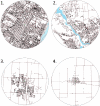Street connectivity is negatively associated with physical activity in Canadian youth
- PMID: 21909310
- PMCID: PMC3166746
- DOI: 10.3390/ijerph8083333
Street connectivity is negatively associated with physical activity in Canadian youth
Abstract
Street connectivity, defined as how well streets connect to one and other and the density of intersections, is positively associated with active transportation in adults. Our objective was to study the relation between street connectivity and physical activity in youth. Study participants consisted of 8,535 students in grades 6-10 from 180 schools across Canada who completed the 2006 Health Behaviour in School-aged Children (HBSC) survey. Street connectivity was measured in a 5 km circular buffer around these schools using established geographic information system measures. Physical activity performed outside of school hours was assessed by questionnaire, and multi-level regression analyses were used to estimate associations with street connectivity after controlling for several covariates. Compared to students living in the highest street connectivity quartile, those in the second (relative risk = 1.22, 95% confidence interval = 1.10-1.35), third (1.25, 1.13-1.37), and fourth (1.21, 1.09-1.34) quartiles were more likely to be physically active outside of school. In conclusion, youth in neighbourhoods with the most highly connected streets reported less physical activity outside of school than youth from neighbourhoods with less connected streets. Relationships between street connectivity and physical activity reported in this national study are in the opposite direction to those previously observed for active transportation in adult populations.
Keywords: adolescent; built environment; physical activity; street connectivity.
Figures


References
-
- Colley RC, Garriguet D, Janssen I, Craig CL, Clarke J, Tremblay MS. Physical activity of Canadian children: Accelerometer results from the 2007 to 2009 Canadian Health Measures Survey. Health Rep. 2011;11:1–11. - PubMed
-
- Troiano RP, Berrigan D, Dodd KW, Masse LC, Tilert T, McDowell M. Physical activity in the United States measured by accelerometer. Med. Sci. Sports Exerc. 2008;40:181–188. - PubMed
-
- Humpel N, Owen N, Leslie E. Environmental factors associated with adults’ participation in physical activity: A review. Am. J. Prev. Med. 2002;22:188–199. - PubMed
-
- Owen N, Humpel N, Leslie E, Bauman A, Sallis JF. Understanding environmental influences on walking: Review and research agenda. Am. J. Prev. Med. 2004;27:67–76. - PubMed
Publication types
MeSH terms
Grants and funding
LinkOut - more resources
Full Text Sources
Medical

